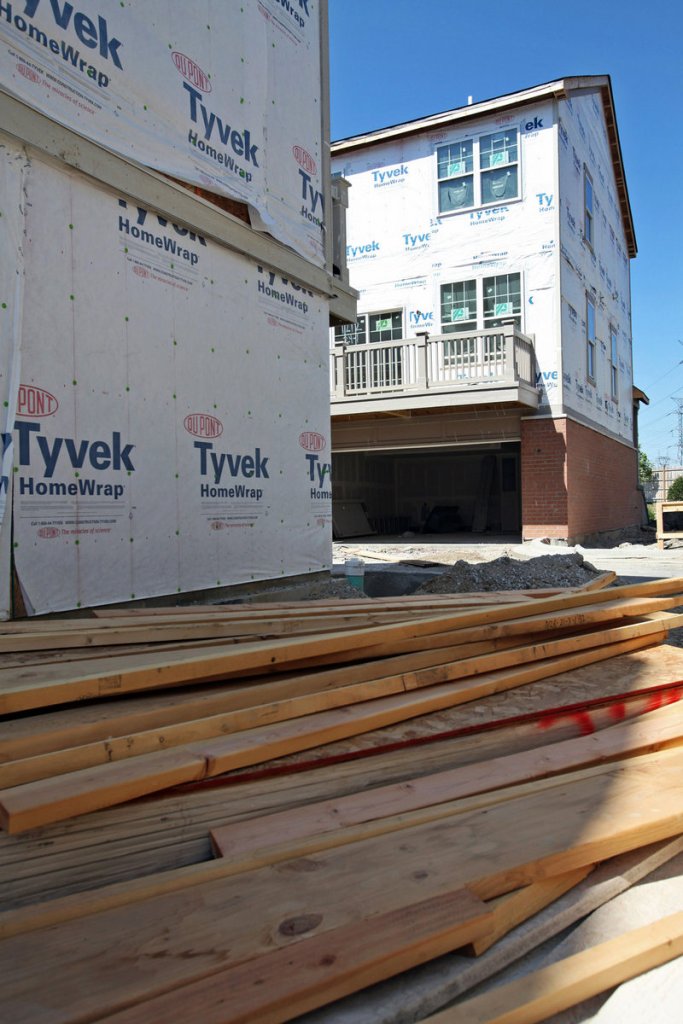North American lumber mills are operating at the fastest pace in four years as U.S. home building rebounds.
But the worst beetle infestation on record has curbed the supply.
About 52.5 billion board feet, the standard industry measure, will be sawed this year, 5.4 percent more than in 2011 and the most since 2008, CIBC World Markets estimates.
Lumber traded on the Chicago Mercantile Exchange may rally 11 percent to $350 per 1,000 board feet by March, the highest since 2006, said Paul Jannke, an analyst at Forest Economic Advisors, a Westford, Mass.-based industry consultant.
Sales expectations among U.S. homebuilders for the next six months turned positive in September for the first time since 2007 as record-low borrowing costs boosted new-home purchases and sent housing starts to a four-year high.
CIBC estimates about 20 percent of North American capacity has been shut or idled by mills, including Weyerhaeuser Co. and Plum Creek Timber Co., as lumber futures slumped to the lowest in at least a quarter century in 2009.
“As demand continues to improve, more capacity will be added, but the market is going to need that capacity,” said Mark Kennedy, a CIBC analyst in Calgary whose recommendations on the shares of forestry and paper companies returned 19 percent in the past six months. “We’ve already seen the lows for the year.”
Housing is gaining traction amid an infestation of mountain-pine beetles that Canadian officials said was the worst ever. Government data show about 51 percent of marketable pine forests in British Columbia, the largest timber-producing province in Canada, were killed as of the summer of 2011, according to International Wood Markets Group, a consultant and newsletter publisher in Vancouver.
While the full impact of the beetle infestation won’t be seen for another three or four years, it’s already reducing lumber quality, said Gerry Van Leeuwen, a vice president at International Wood Markets Group.
The beetles have cut the amount of wood suitable for use in house frames to about 70 to 75 feet for every 100 feet produced, from 85 feet a decade ago, he said. The insect, native to North America, damages trees by burrowing into their bark.
Demand for North American lumber, a market valued at about $20 billion a year, will rise to 52.5 billion board feet in 2012, from 49.8 billion in 2011, CIBC estimates. The figures include U.S. and Canadian consumption and net exports, based on standard boards 1 inch thick and a foot wide. A typical U.S. home uses about 16,000 board feet of lumber.
While U.S. housing is recovering, weakening economic growth elsewhere may curb the rally in lumber futures.
China used almost 10 percent of the softwood lumber produced globally last year, according to Hakan Ekstrom, president of Wood Resources International in Bothell, Wash. The nation’s imports of logs and lumber fell 19 percent in the first eight months from a year earlier, he said.
China reported slower growth for the seventh consecutive quarter Thursday, according to the statistics office.
New-home construction surged 15 percent in September to the highest in four years, Commerce Department figures showed last week. Building permits, a proxy for future construction, jumped to the highest since July 2008.
Builders will need to increase housing starts to an annual rate of at least 830,000, from a monthly average pace of 612,000 last year, to keep home inventories from declining further, Jannke of Forest Economic Advisors said.
The rebound in U.S. housing is adding to evidence of a sustained economic expansion, after retail sales and industrial production rose more than analysts expected in September. The economy will expand 2.1 percent this year, from 1.8 percent in 2011, according to the median of 99 economist estimates compiled by Bloomberg. Growth may slow to 2 percent next year before accelerating to 2.7 percent in 2014, the survey showed.
Housing is “showing signs of life” and it should be one of the key drivers of economic growth in the next few years, John Williams, the president of the Federal Reserve Bank of San Francisco, said in a speech last week.
The North American mill industry is operating at about 79 percent of its current operating capacity of 66 billion board feet of lumber a year. Producers are often able to boost prices as operating rates reach 80 percent, CIBC’s Kennedy said.
Owners so far have refrained from bringing idled plants back on line, and demand may recover faster than they expect, according to Forest Economic Advisors’ Jannke.
“Because there were so many mill closures during the downturn, we’re going to suddenly hit a wall of tight supply,” Patricia Mohr, an economist and commodity specialist at Scotiabank in Toronto, said in a telephone interview. “My feeling for next year is that we’re going to see markedly higher lumber prices with even a modest recovery in U.S. housing.”
Send questions/comments to the editors.



Success. Please wait for the page to reload. If the page does not reload within 5 seconds, please refresh the page.
Enter your email and password to access comments.
Hi, to comment on stories you must . This profile is in addition to your subscription and website login.
Already have a commenting profile? .
Invalid username/password.
Please check your email to confirm and complete your registration.
Only subscribers are eligible to post comments. Please subscribe or login first for digital access. Here’s why.
Use the form below to reset your password. When you've submitted your account email, we will send an email with a reset code.